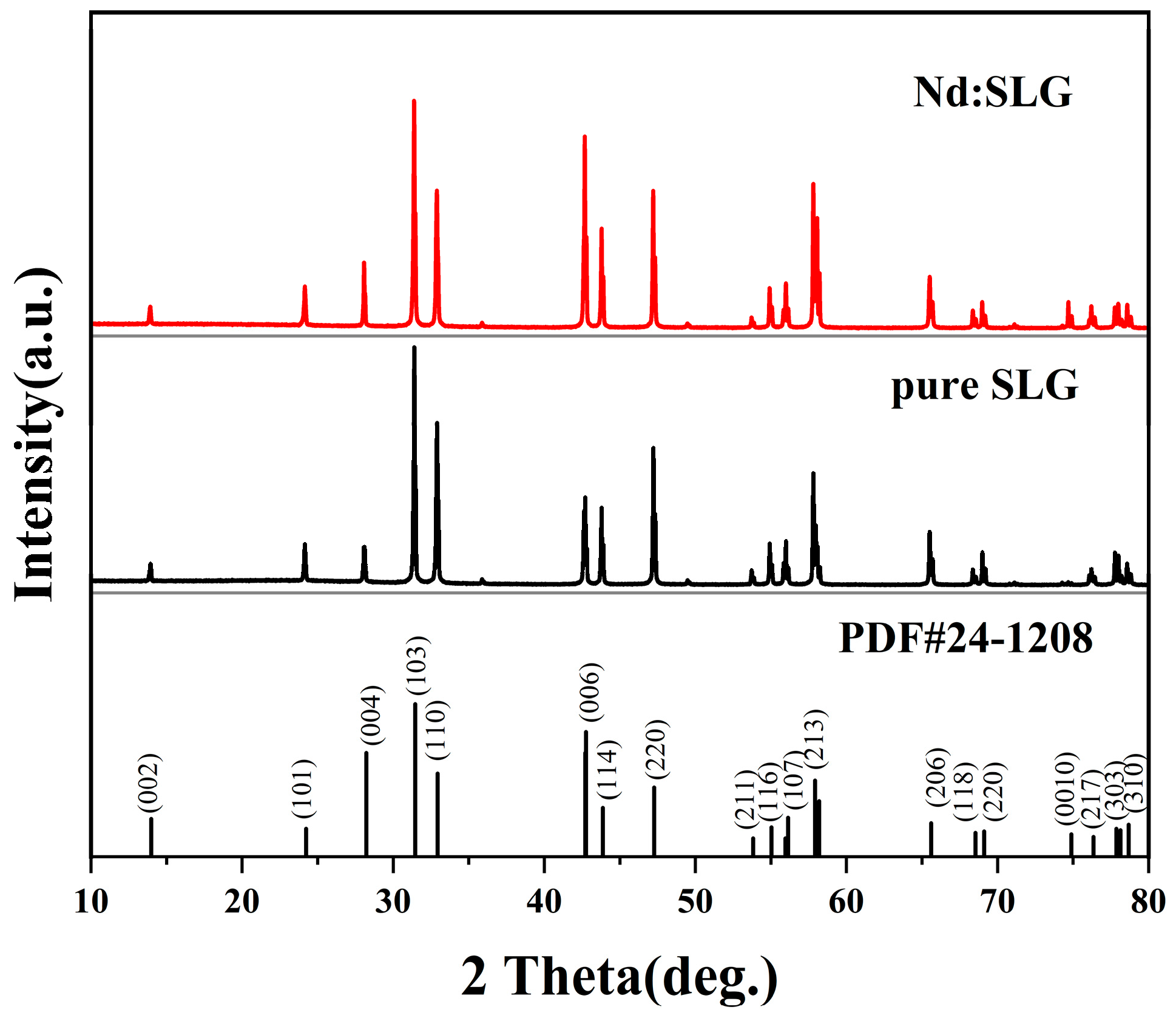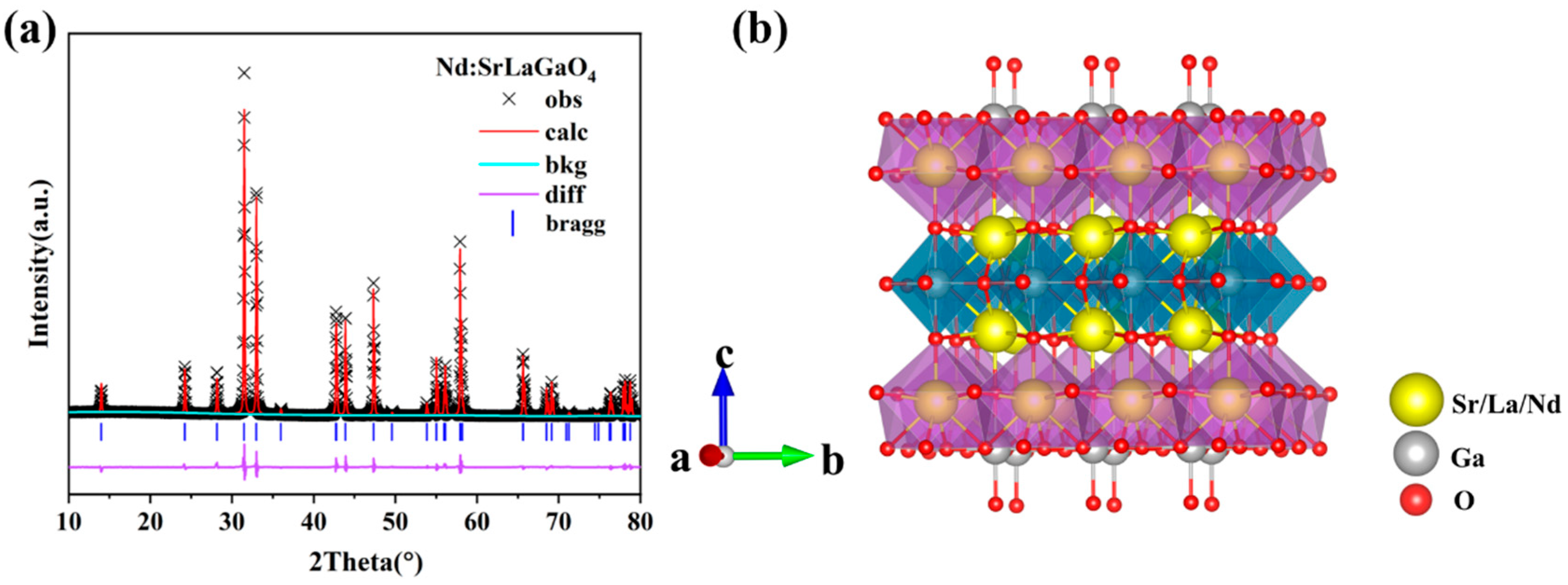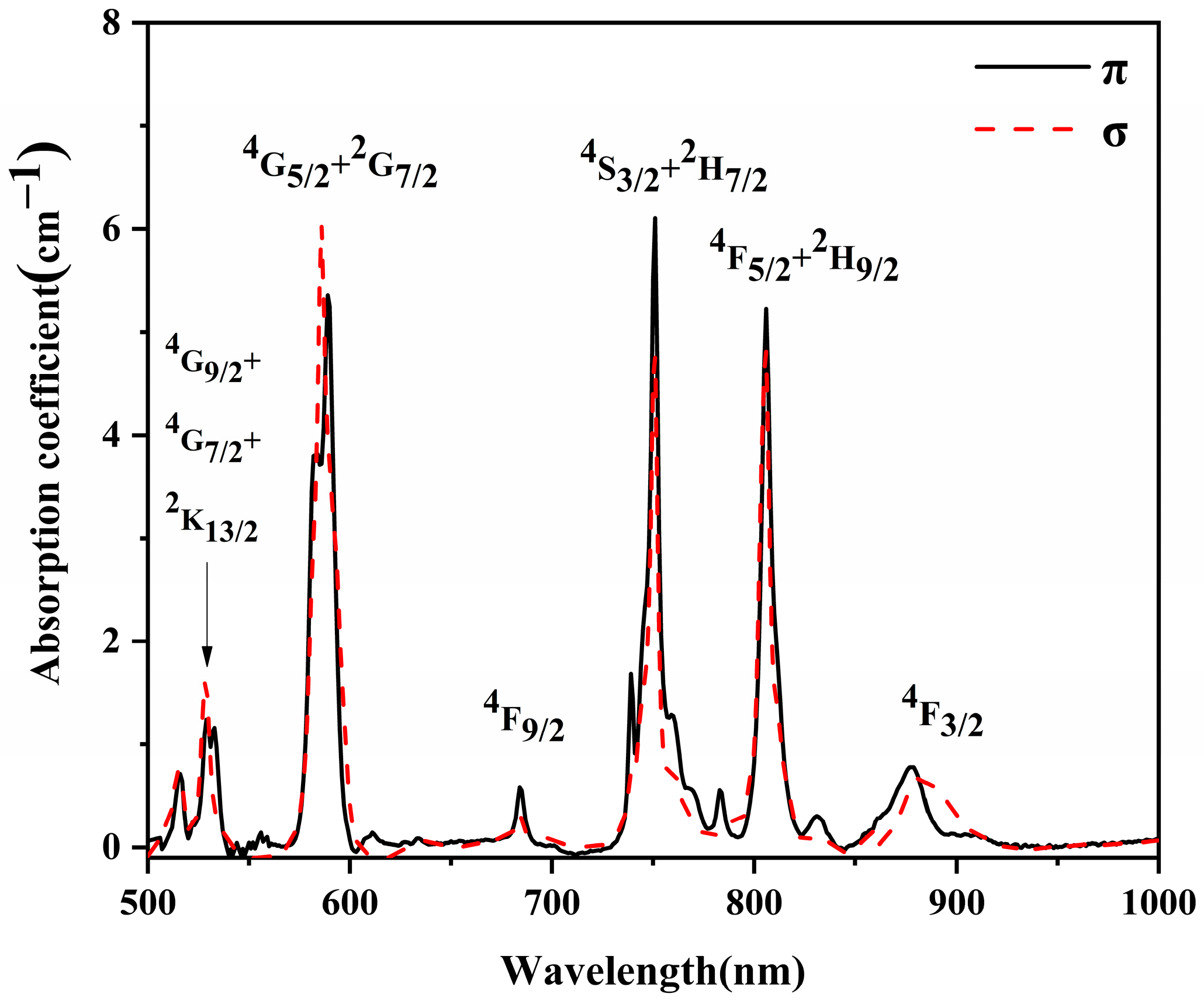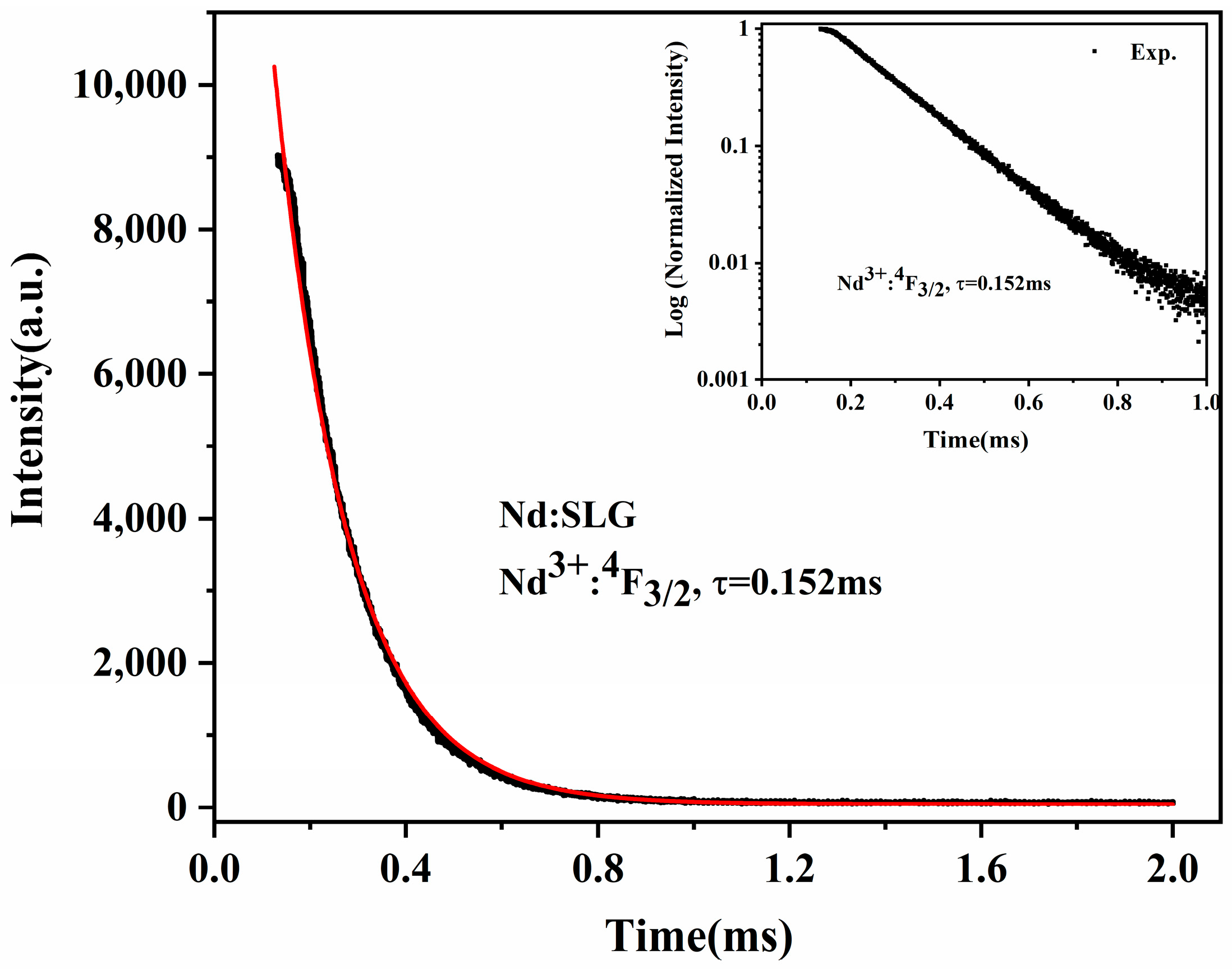Growth, Structure, and Spectroscopic Properties of a Disordered Nd:SrLaGaO4 Laser Crystal
Abstract
1. Introduction
2. Experiment
3. Results and Discussion
3.1. Crystal Structure and Segregation
3.2. Refractive Index
3.3. Absorption Spectra and Judd–Ofelt (J-O) Theory Analyses
3.4. Fluorescence Spectra
4. Conclusions
- XRD was used to verify the unchanged tetragonal structure of the Nd3+-doped crystal. The Nd3+, Sr3+, and La3+ ions were distributed randomly with C4v symmetry. The calculated lattice concentration and effective segregation coefficient of Nd3+ ions were 1.27 × 10−20 ions/cm3 and 0.48.
- The refractive index of the Nd:SLG crystal was measured by the minimum deviation technique with a right-angle prism sample. The refractive index dispersion equation was fitted by the least squares method. The results reveal that the SLG crystal is a positive uniaxial crystal.
- The polarized absorption spectra of the Nd:SLG crystal were measured at room temperature. The maximum absorption cross sections of π- and σ-polarization at 806 nm were 3.73 × 10−20 and 4.05× 10−20 cm2, and the corresponding FWHMs were 6.00 and 6.10 nm, respectively. Based on the J-O analysis, the 4F3/2 → 4I11/2 transition around 1.0 μm had the largest fluorescence branch ratio of 48.88%.
- The stimulated emission cross sections at 1076 nm were calculated as 3.97 × 10−20 cm2 for π-polarization and 4.12 × 10−20 cm2 for σ-polarization, and the corresponding FWHMs were 30.21 and 19.44 nm, respectively. The decay lifetime of the Nd3+:4F3/2 energy level of Nd3+ ions at 1076 nm was fitted to 0.152 ms by a single exponential.
Author Contributions
Funding
Data Availability Statement
Conflicts of Interest
References
- Wei, M.; Cheng, T.; Dou, R.; Zhang, Q.-L.; Jiang, H. Superior performance of a 2 kHz pulse Nd:YAG laser based on a gradient-doped crystal. Photonics Res. 2021, 9, 1191–1196. [Google Scholar] [CrossRef]
- Li, G.; Zhou, Q.; Xu, G.; Wang, X.; Han, W.; Wang, J.; Zhang, G.; Zhang, Y.; Yuan, Z.; Song, S.; et al. Lidar-radar for underwater target detection using a modulated sub-nanosecond Q-switched laser. Opt. Laser Technol. 2021, 142, 107234. [Google Scholar] [CrossRef]
- Qian, C.; Jiang, Y.; Wu, Y.; Yue, B.; Yan, S.; Lu, Z. The comparison of the efficacy and safety of fractional 1064 nm Nd:YAG picosecond laser and nonablative fractional 1565 nm laser in the treatment of enlarged pores: A prospective split-face study. Lasers Surg. Med. 2023, 55, 169–177. [Google Scholar] [CrossRef]
- Yun, Q.; Song, B.; Pei, Y. Modeling the impact of high energy laser weapon on the mission effectiveness of unmanned combat aerial vehicles. IEEE Access 2020, 8, 32246–32257. [Google Scholar] [CrossRef]
- Wu, G.; Bai, L.; Yu, P.; Fan, M.; Sun, L.; Li, Y.; Yu, F.; Wang, Z.; Zhao, X. Growth, optical, and spectroscopic properties of pure and Nd3+-doped GdSr3(PO4)3 crystals with disordered structure. Inorg. Chem. 2022, 61, 170–177. [Google Scholar] [CrossRef]
- Zhao, M.; Liu, X.; Xu, X.; Liu, J. Ultrafast operation on a novel Nd:LaMgAl11O19 disordered crystal laser. Infrared Phys. Technol. 2022, 124, 104227. [Google Scholar] [CrossRef]
- Wang, Z.; Liu, J.; Chen, P.; Liu, P.; Ma, J.; Xu, X.; Wei, Y.; Lebbou, K.; Xu, J. Growth and Characterization of Yb:CALYGLO Crystal for Ultrashort Pulse Laser Applications. Crystals 2024, 14, 120. [Google Scholar] [CrossRef]
- Sun, L.; Lu, J.; Xu, Q.; Su, S.; Liu, R.; Lei, Z.; Xu, K.; Zou, Y.; Zhang, B.; Li, J.; et al. Crystal growth and spectral properties of a mixed crystal Nd3+:LuYPO4. J. Lumin. 2024, 266, 120297. [Google Scholar] [CrossRef]
- Niu, X.; Chen, H.; Zhang, P.; Yin, H.; Hang, Y.; Li, Z.; Lin, W.; Chen, Z. Novel laser crystal Nd3+: Ca(Y, Gd)AlO4: A promising candidate for laser operation beyond 1.37 μm. J. Alloys Compd. 2023, 938, 168613. [Google Scholar] [CrossRef]
- Wu, A.; Ding, J.; Xu, J.; Shen, H.; Ogawa, T.; Wada, S. Crystal growth and optical performance of Nd:Sr3Ga2Ge4O14 crystals. Phys. Status Solidi A 2008, 205, 1177–1180. [Google Scholar] [CrossRef]
- Jiao, Y.; Liu, Z.; Zhang, X.; Gao, F.; Jia, C.; Chen, X.; Cong, Z. Diode-pumped actively Q-switched Nd:YVO4/RTP intracavity raman laser at 1.49 µm. Crystals 2019, 9, 168. [Google Scholar] [CrossRef]
- Xiao, H.; Zhao, T.; Ge, W.; Zhong, Q.; Li, M.; Yu, J.; Fan, Z.; Bian, S.; Chen, Y. High stability LED-pumped Nd:YVO4 laser with a Cr:YAG for passive Q-switching. Crystals 2019, 9, 201. [Google Scholar] [CrossRef]
- Liu, J.; Duan, Y.; Mao, W.; Jin, X.; Li, Z.; Zhu, H. An axicon-based annular pump acousto-optic Q-switched Nd:GdVO4 self-raman vortex laser. Crystals 2023, 13, 1484. [Google Scholar] [CrossRef]
- Zhang, Y.; Huang, C.; Xu, M.; Fang, Q.; Li, S.; Lin, W.; Deng, G.; Zhao, C.; Hang, Y. Nd:GdScO3 crystal: Polarized spectroscopic, thermal properties, and laser performance at 1.08 μm. Opt. Laser Technol. 2023, 167, 109709. [Google Scholar] [CrossRef]
- Chen, H.; Zhang, P.; Song, J.; Yin, H.; Hang, Y.; Yang, Q.; Li, Z.; Chen, Z. Spectral broadening of a mixed Nd:CYGA crystal with tunable laser operation beyond 1100 nm. Opt. Express 2022, 30, 21943–21951. [Google Scholar] [CrossRef] [PubMed]
- Yuan, F.; Liao, W.; Huang, Y.; Zhang, L.; Sun, S.; Wang, Y.; Lin, Z.; Wang, G.; Zhang, G. A new ~1 μm laser crystal Nd:Gd2SrAl2O7: Growth, thermal, spectral and lasing properties. J. Phys. D Appl. Phys. 2018, 51, 125307. [Google Scholar] [CrossRef]
- Zhao, M.; Zhang, Z.; Feng, X.; Zong, M.; Liu, J.; Xu, X.; Zhang, H. High repetition rate passively Q-switched laser on Nd:SRA at 1049 nm with MXene Ti3C2Tx. Chin. Opt. Lett. 2020, 18, 21–24. [Google Scholar] [CrossRef]
- Li, Y.; Jia, Z.; Nie, H.; Yin, Y.; Fu, X.; Mu, W.; Zhang, J.; Zhang, B.; Li, S.; Tao, X. Nd doped CaYAl3O7: Exploration and laser performance of a novel disordered laser crystal. CrystEngComm 2020, 22, 4723–4729. [Google Scholar] [CrossRef]
- Zhang, T.; Zhou, L.; Zheng, W.; Xu, B.; Wang, Y.; Tu, C. Laser performance of diode-pumped continuous-wave Nd:CaLaGa3O7 laser with a 22-nm wavelength tunability. Opt. Mater. 2021, 115, 111022. [Google Scholar] [CrossRef]
- Zhang, Y.; Zhang, S.; Gong, Q.; Fang, Q.; He, M.; Huang, C.; Li, S.; Zhang, X.; Xia, C.; Zhao, C.; et al. Structure and spectroscopic properties of a disordered Nd:CaGdAl3O7 crystal. Infrared Phys. Technol. 2023, 131, 104639. [Google Scholar] [CrossRef]
- Liu, S.D.; Dong, L.L.; Zheng, L.H.; Berkowski, M.; Su, L.B.; Ren, T.Q.; Peng, Y.-D.; Hou, J.; Zhang, B.-T.; He, J.-L. High-power femtosecond pulse generation in a passively mode-locked Nd:SrLaAlO4 laser. Appl. Phys. Express 2016, 9, 072701. [Google Scholar] [CrossRef]
- Di, J.; Sun, X.; Xu, X.; Xia, C.; Sai, Q.; Yu, H.; Wang, Y.; Zhu, L.; Gao, Y.; Guo, X. Growth and spectral characters of Nd:CaGdAlO4 crystal. Eur. Phys. J. Appl. Phys. 2016, 74, 10501. [Google Scholar] [CrossRef]
- Li, D.Z.; Xu, X.D.; Cheng, S.S.; Zhou, D.H.; Wu, F.; Zhao, Z.W.; Xia, C.T.; Xu, J.; Zhang, J.; Zhu, H.M.; et al. Polarized spectral properties of Nd3+ ions in CaYAlO4 crystal. Appl. Phys. B-Lasers Opt. 2010, 101, 199–205. [Google Scholar] [CrossRef]
- Yang, H.; Jin, P.; Su, J.; Xu, X.; Xu, J.; Lu, H. Realization of a continuous-wave single-frequency tunable Nd: CYA laser. Chin. Opt. Lett. 2022, 20, 031403. [Google Scholar] [CrossRef]
- Hontsu, S.; Ishii, J.; Kawai, T.; Kawai, S. LaSrGaO4 substrate gives oriented crystalline YBa2Cu3O7-y films. Appl. Phys. Lett. 1991, 59, 2886–2888. [Google Scholar] [CrossRef]
- Dabkowski, A.; Dabkowski, H.A.; Greedan, J.E. SrLaGaO4-Czochralski crystal growth and basic properties. J. Cryst. Growth 1993, 132, 205–208. [Google Scholar] [CrossRef]
- Ryba-Romanowski, W.; Gołąb, S.; Pisarski, W.; Dominiak-Dzik, G.; Gloubokov, A. Optical Study of SrLaGaO4 and SrLaGa3O7 Doped with Nd3+ and Yb3+. Acta Phys. Pol. A 1996, 90, 399–405. [Google Scholar] [CrossRef]
- Zhang, Y.; Zhang, H.; Yu, H.; Sun, S.; Wang, J.; Jiang, M. Characterization of Disordered Melilite Nd:SrLaGa3O7 Crystal. IEEE J. Quantum Electron. 2011, 47, 1506–1513. [Google Scholar] [CrossRef]
- Pan, Y.; Liu, B.; Liu, J.; Song, Q.; Xu, J.; Li, D.; Liu, P.; Ma, J.; Xu, X.; Lin, H.; et al. Polarized spectral properties and laser operation of Nd: SrAl12O19 crystal. J. Lumin. 2021, 235, 118034. [Google Scholar] [CrossRef]
- Lomheim, T.S.; DeShazer, L.G. Optical-absorption intensities of trivalent neodymium in the uniaxial crystal yttrium orthovanadate. J. Appl. Phys. 1978, 49, 5517–5522. [Google Scholar] [CrossRef]
- Dong, J.; Rapaport, A.; Bass, M.; Szipocs, F.; Ueda, K. Temperature-dependent stimulated emission cross section and concentration quenching in highly doped Nd3+:YAG crystals. Phys. Status Solidi A 2005, 202, 2565–2573. [Google Scholar] [CrossRef]
- Liu, Y.; Pan, F.; Gao, J.; Tu, C. Nd3+ doped CaLaGa3O7: Growth, structure, and optical properties of a disordered laser crystal. J. Lumin. 2022, 244, 118748. [Google Scholar] [CrossRef]
- Zhang, Y.Y.; Zhang, H.J.; Yu, H.H.; Wang, J.Y.; Gao, W.L.; Xu, M.; Sun, S.Q.; Jiang, M.H.; Boughton, R.I. Synthesis, growth, and characterization of Nd-doped SrGdGa3O7 crystal. J. Appl. Phys. 2010, 108, 063534. [Google Scholar] [CrossRef]
- Sato, Y.; Taira, T. Comparative study on the spectroscopic properties of Nd: GdVO4 and Nd:YVO4 with hybrid process. IEEE J. Sel. Top. Quantum Electron. 2005, 11, 613–620. [Google Scholar] [CrossRef]
- Liu, S.; Dong, L.; Zhang, X.; Yao, Y.; Xu, Y.; Ren, T.; Zheng, L.; Su, L.; Berkowski, M. Thermal, spectral properties and Q-switched laser operation of Nd:SrLaAlO4 crystal. Opt. Mater. 2017, 64, 351–355. [Google Scholar] [CrossRef]
- Kushida, T.; Marcos, H.M.; Geusic, J.E. Laser transition cross section and fluorescence branching ratio for Nd3+ in yttrium aluminum garnet. Phys. Rev. 1968, 167, 289. [Google Scholar] [CrossRef]
- Singh, S.; Smith, R.G.; Van Uitert, L.G. Stimulated-emission cross section and fluorescent quantum efficiency of Nd3+ in yttrium aluminum garnet at room temperature. Phys. Rev. B 1974, 10, 2566–2572. [Google Scholar] [CrossRef]






| Name | X | Y | Z | Wyckoff Site | Uiso |
|---|---|---|---|---|---|
| Sr1 | 0 | 0 | 0.3588 | 4e | 0.00425 |
| La1 | 0 | 0 | 0.3588 | 4e | 0.00992 |
| Ga1 | 0 | 0 | 0 | 2a | 0.01715 |
| O1 | 0 | 0 | 0.1680 | 4e | 0.00914 |
| O2 | 0 | 0.5 | 0 | 4c | 0.01923 |
| Nd6 | 0 | 0 | 0.3588 | 4e | 0.00250 |
| λ (nm) | Refractive Index | |
|---|---|---|
| no | ne | |
| 546.0750 | 2.0159794 | 2.0329168 |
| 587.5620 | 2.0099844 | 2.0259665 |
| 643.8470 | 2.0039589 | 2.0184998 |
| 706.5190 | 1.9980698 | 2.0114033 |
| 768.1943 | 1.9931367 | 2.0079149 |
| 852.1100 | 1.9886278 | 2.0034969 |
| 1013.9800 | 1.9833680 | 1.9963757 |
| Nd3+ 5I8→ | σ-Polarized | π-Polarized | ||||
|---|---|---|---|---|---|---|
| λ (nm) | λ (nm) | |||||
| 10−20 cm2 | 10−20 cm2 | |||||
| 4G9/2 + 4G7/2 + 2K13/2 | 529 | 7.059 | 6.032 | 529 | 6.099 | 4.673 |
| 4G5/2 + 2G7/2 | 586 | 18.68 | 18.74 | 589 | 20.93 | 21 |
| 4F9/2 | 684 | 1.08 | 0.549 | 684 | 0.616 | 0.633 |
| 4S3/2 + 2H7/2 | 751 | 7.239 | 6.627 | 751 | 9.355 | 8.583 |
| 4F5/2 + 2H9/2 | 806 | 6.126 | 7.086 | 806 | 5.755 | 6.922 |
| 4F3/2 | 883 | 2.909 | 2.653 | 879 | 1.629 | 1.2 |
| RMSΔS | 0.293 | 0.243 | ||||
| Crystal | Ω2,4,6 (10−20 cm2) | Ref. | |||
|---|---|---|---|---|---|
| Ω2 | Ω4 | Ω6 | Ω4/Ω6 | ||
| Nd:SLG | 3.28 | 2.97 | 3.61 | 0.82 | This work |
| Nd:YAG | 0.62 | 1.70 | 5.76 | 0.29 | [31] |
| Nd:SrLaGa3O7 | 1.28 | 5.01 | 1.95 | 2.57 | [28] |
| Nd:CaLaGa3O7 | 5.804 | 10.586 | 3.443 | 3.07 | [32] |
| Nd:YVO4 | 5.88 | 4.08 | 5.11 | 0.80 | [30] |
| Nd:CaYAlO4 | 2.19 | 8.16 | 8.57 | 0.95 | [23] |
| Transition | λ (nm) | Aed (s−1) | β (%) | τrad (ms) | |
|---|---|---|---|---|---|
| 4F3/2→ | 0.21 | ||||
| 4I15/2 | 1852 | 23.99864 | 0.51 | ||
| 4I13/2 | 1333 | 465.4819 | 9.95 | ||
| 4I11/2 | 1053 | 2290.509 | 48.95 | ||
| 4I9/2 | 881 | 1898.881 | 40.58 | ||
| Crystal | λabs (nm) | σabs (10−20 cm2) | FWHM (nm) | λem (nm) | σem (10−20 cm2) | FWHM (nm) | τf (μs) | Refs. |
|---|---|---|---|---|---|---|---|---|
| YAG | 808 | 7.3 | 1 | 1064 | 28 | 0.8 | 230 | [36,37] |
| YVO4 | 808.7(π) | 38.7(π) | 1.9(π) | 1066(σ) | 29.5(σ) | 3.5(σ) | 84.1 | [34] |
| CaYAlO4 | 806(σ) | 9.7(σ) | 5(σ) | 1080(σ) | 10.44(σ) | 12(σ) | 129 | [23] |
| CaGdAlO4 | 809(π) | 6.8(π) | 4(π) | 1067(π) | 12.5 | 18(π) | 123 | [22] |
| 809(σ) | 7.5(σ) | 5(σ) | 1068(σ) | 11(σ) | ||||
| SrLaAlO4 | 808(σ) | 2.44(σ) | 17(σ) | 1075(σ) | 3.8(σ) | / | 138 | [35] |
| 808(π) | 2.43(π) | 17(π) | 1065–1078(π) | 5.2–5.5(π) | 34(π) | |||
| CaYAl3O7 | 808(σ) | 5.34(σ) | 20.2(σ) | 1062(σ) | 4.55(σ) | 14.4(σ) | 261 | [18] |
| 808(π) | 3.51(π) | 20.2(π) | 1062(π) | 5.97(π) | 14(π) | |||
| CaGdAl3O7 | 808.5 | 3.78 | 19.3 | 1061.6 | 4.94 | 12.7 | 260.7 | [20] |
| CaLaGa3O7 | 808(σ) | 1.34(σ) | 10(σ) | 1061(σ) | 6.9(σ) | 27.8(σ) | 250 | [32] |
| 808(π) | 3.18(π) | 16(π) | 1061(π) | 7.23(π) | 18.8(π) | |||
| Gd2SrAl2O7 | 808(σ) | 11.84(σ) | 3.4(σ) | 1080 | 12.7(σ) | 12.5(σ) | 118 | [16] |
| 807.5(π) | 13.7(π) | 3.3(π) | 1080 | 15(π) | 5.1(π) | |||
| SrLaGaO4 | 806(σ) | 4.05(σ) | 6.1(σ) | 1076(σ) | 4.12(σ) | 19.44(σ) | 152 | This work |
| 806(π) | 3.73(π) | 6(π) | 1076(π) | 3.97(π) | 30.21(π) |
Disclaimer/Publisher’s Note: The statements, opinions and data contained in all publications are solely those of the individual author(s) and contributor(s) and not of MDPI and/or the editor(s). MDPI and/or the editor(s) disclaim responsibility for any injury to people or property resulting from any ideas, methods, instructions or products referred to in the content. |
© 2024 by the authors. Licensee MDPI, Basel, Switzerland. This article is an open access article distributed under the terms and conditions of the Creative Commons Attribution (CC BY) license (https://creativecommons.org/licenses/by/4.0/).
Share and Cite
Fang, S.; Liang, L.; Wang, W.; Lin, Y.; Sun, Y.; Gong, G.; Tu, C.; Wen, H. Growth, Structure, and Spectroscopic Properties of a Disordered Nd:SrLaGaO4 Laser Crystal. Crystals 2024, 14, 174. https://doi.org/10.3390/cryst14020174
Fang S, Liang L, Wang W, Lin Y, Sun Y, Gong G, Tu C, Wen H. Growth, Structure, and Spectroscopic Properties of a Disordered Nd:SrLaGaO4 Laser Crystal. Crystals. 2024; 14(2):174. https://doi.org/10.3390/cryst14020174
Chicago/Turabian StyleFang, Shanshan, Ling Liang, Wei Wang, Yiyang Lin, Yijian Sun, Guoliang Gong, Chaoyang Tu, and Herui Wen. 2024. "Growth, Structure, and Spectroscopic Properties of a Disordered Nd:SrLaGaO4 Laser Crystal" Crystals 14, no. 2: 174. https://doi.org/10.3390/cryst14020174
APA StyleFang, S., Liang, L., Wang, W., Lin, Y., Sun, Y., Gong, G., Tu, C., & Wen, H. (2024). Growth, Structure, and Spectroscopic Properties of a Disordered Nd:SrLaGaO4 Laser Crystal. Crystals, 14(2), 174. https://doi.org/10.3390/cryst14020174






